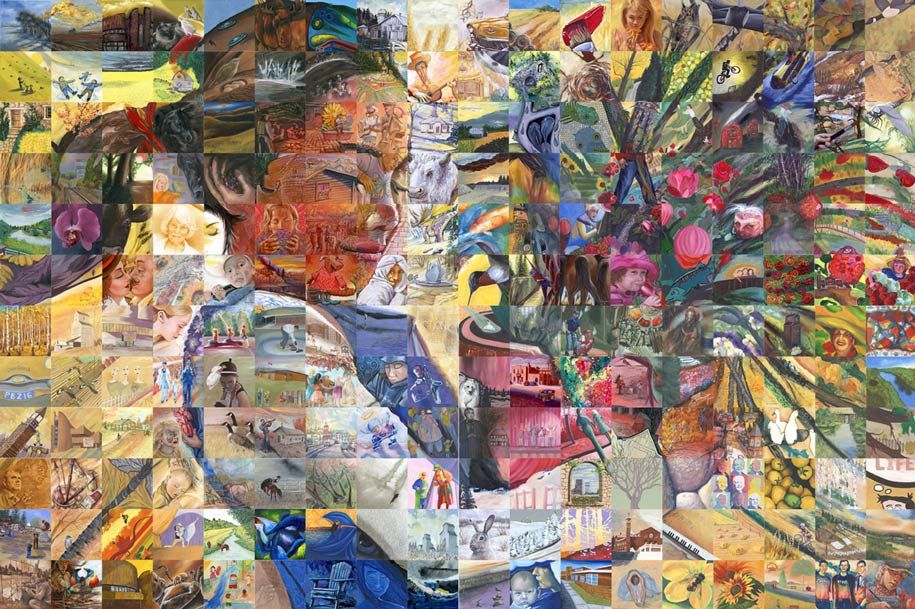The Dynamic World of Collage Painting Artists
Collage painting artists occupy a unique and intriguing space in the art world, where they blend traditional techniques with modern innovation. This artistic medium allows for the fusion of various materials and ideas, resulting in captivating and multidimensional works of art. Collage painting artists wield scissors and paintbrushes to create visual stories that are rich in texture, depth, and meaning. In this article, we will delve into the world of collage painting artists, exploring their history, techniques, notable practitioners, and the impact of this versatile art form on contemporary art.
The Evolution of Collage Painting Artists
The origins of collage art can be traced back to ancient civilizations, where craftsmen and artists used fragments of paper, textiles, and other materials to create mosaics, tapestries, and manuscripts. However, it was in the early 20th century that collage as we know it today truly began to take shape. Pablo Picasso and Georges Braque, pioneers of the Cubist movement, are often credited with introducing collage techniques to the modern art world. Their groundbreaking work, such as Picasso’s “Still Life with Chair Caning” (1912), incorporated fragments of everyday objects and materials into their paintings, challenging the traditional boundaries of art.
This revolutionary approach to art-making inspired a generation of artists to experiment with Collage Painting Artists, giving rise to a diverse array of styles and expressions. Collage painting, as a distinct genre, began to gain prominence in the mid-20th century and has continued to evolve to this day.
Techniques in Collage Painting
Collage painting artists employ a wide range of techniques, each offering unique opportunities for self-expression and creativity. Here are some of the fundamental techniques commonly used in collage painting:
- Layering: Layering involves placing pieces of various materials on top of one another to create depth and texture. This technique allows artists to convey intricate narratives and emotions within their works.
- Overpainting: Overpainting is the process of painting over the collage elements, blending them with the painted surface to create a cohesive composition. This technique is often used to unify the disparate elements in a collage.
- Decoupage: Decoupage is a technique in which paper cutouts or printed images are glued onto a surface and then sealed with varnish or adhesive. This technique is particularly popular in mixed media collage painting.
- Photomontage: Photomontage involves the use of photographs or photographic elements in the collage. Artists can manipulate and arrange these images to create surreal and thought-provoking compositions.
- Found Objects: Incorporating found objects, such as old keys, buttons, or other small items, into a collage can add a sense of nostalgia and whimsy to the artwork. These objects can often carry personal or cultural significance.
Notable Collage Painting Artists
- Romare Bearden (1911-1988): Romare Bearden is considered one of the most influential collage artists of the 20th century. His work often featured scenes of African American life and was a powerful voice in the civil rights movement. Bearden’s collage technique combined various materials, including photographs, paint, and printed images, to create intricate, narrative-rich artworks.
- Hannah Höch (1889-1978): As a member of the Dada movement, Hannah Höch was a pioneering collage artist in the early 20th century. Her photomontage works explored issues of gender, identity, and society. Höch’s bold and thought-provoking pieces challenged traditional gender roles and societal norms.
- Robert Rauschenberg (1925-2008): Robert Rauschenberg was a leading figure in the Pop Art movement. His “combines” incorporated found objects, photographs, and paint to create multimedia collage paintings. Rauschenberg’s work blurred the boundaries between art and life, inviting viewers to reconsider their understanding of art.
- Wangechi Mutu (b. 1972): A contemporary artist known for her mixed media collage paintings, Wangechi Mutu explores themes of feminism, identity, and African diaspora. Her work often combines anatomical imagery, natural elements, and found materials to challenge and engage viewers.
Impact on Contemporary Art
Collage painting has left an indelible mark on contemporary art. It continues to inspire artists to experiment with materials, concepts, and techniques. The genre’s versatility allows artists to bridge the gap between traditional and modern art, leading to a diverse range of expressions that resonate with today’s audiences.
One notable aspect of collage painting’s impact on contemporary art is its capacity for storytelling. Artists use collage techniques to weave intricate narratives that reflect the complexities of our modern world. Whether addressing social, political, or personal themes, collage painting provides a dynamic platform for artists to communicate their perspectives.
Additionally, collage painting has become a medium for exploring cultural and historical aspects of identity. Contemporary artists often incorporate found materials that carry cultural significance, allowing them to comment on heritage, traditions, and the evolving nature of identity in a globalized world.
The digital age has also seen a surge in digital collage art, where artists use software to create collages from an array of digital images. This fusion of traditional and digital collage techniques adds another layer of innovation to the medium.
Conclusion
Collage painting artists occupy a distinctive and transformative space within the art world, combining diverse materials and ideas to create intricate and engaging works of art. From its early pioneers like Picasso and Braque to contemporary visionaries like Wangechi Mutu, collage painting has been a catalyst for innovation, challenging the boundaries of artistic expression.
As collage art painting continues to evolve and inspire, it reaffirms its role as a dynamic and relevant medium in contemporary art. Through layering, overpainting, decoupage, photomontage, and the incorporation of found objects, artists bring together disparate elements to create pieces that captivate, provoke, and invite viewers to explore the boundless possibilities of this captivating art form.







